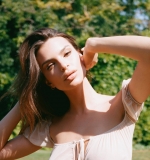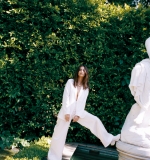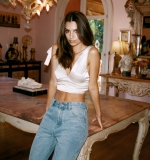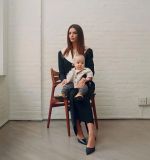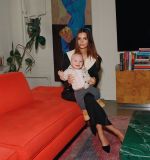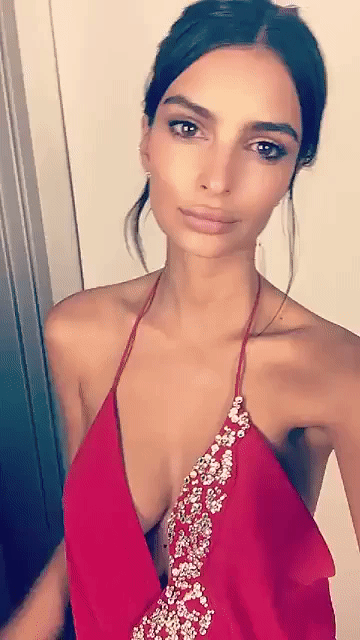The supermodel and best-selling writer has a new baby, a new podcast, and a new outlook on life.
It is a rainy afternoon in New York’s West Village when I see that Emily Ratajkowski is already waiting for me at a small outdoor cafe table at Buvette, the popular French-inspired bistro. She smiles and embraces me as if we are friends and not two strangers who have only just met. She is dressed in a loose brown T-shirt layered over a pair of printed flared jersey leggings. She had thought about what to wear today in a way I find deeply relatable. “There was a top that matched these pants, but it was tight”, she says. “I thought it was showing my body in a way, so I switched it out”. Women are always thinking of what our appearance is signaling, especially to other women.
No one would know this better than Ratajkowski.
Instantly, I experience the effect her presence has on the world. After all, Ratajkowski’s image is everywhere: on social media (where she has more than 29 million Instagram followers) and splashed across the internet, where her outfits and whereabouts are breathlessly chronicled. Buvette’s waiters are all beatifically smiling at us in a reverential manner I have never encountered before. Busy passersby do double takes, the expressions on their faces softening as they recognize who she is. Later, a young woman pulls out her phone to snap a photo of us, not even attempting discretion, and a pair of tourists from Mexico interrupt our lunch to ask her for selfies, a request Ratajkowski gamely indulges.
We are here to discuss Ratajkowski’s plans to launch a podcast called High Low with EmRata on November 1. She tells me she pitched it as if Call Her Daddy met Fresh Air. “I’m down to talk about sex, be a millennial or whatever, while also having—hopefully—the eloquence and interview style of Terry Gross”, she explains. It will be two episodes a week, with an additional weekly episode for paid subscribers. One of the weekly podcasts will be an interview, the other a monologue by Ratajkowski. She will invite a mix of guests, both “high and low”, she says, bringing together experts and celebrities, intellectuals and entertainers. Her monologues, which she’s calling “EmRata Asks”, will be more like a philosophical attempt to address a question; she’ll use the time to discuss both sides of the argument or possibly even reframe the issue. The other day, she recorded one where she asked, “Can you be a feminist and still get plastic surgery?” “There’s going to be a lot of stuff that is about women, just because that’s what I’m interested in”, she says. “I have to be honest, I totally love it”.
The eclecticism of the show makes sense. After all, the model, actor, and, as of last year, best-selling author is one of those people whose celebrity is not attributable to any single accomplishment or idea. (“I say ‘multihyphenate’ now because when people say ‘writer, actor, entrepreneur, activist’, I want to throw up”, she tells me.) Explaining her to the uninitiated isn’t easy. She’s a model! But also a writer! She’s a feminist! And a socialist! She’s been in movies! You should really watch her Instagram Stories! But of those, there are few. That’s because Emrata—Ratajkowski’s social handle and de facto moniker—has become a kind of cultural phenomenon.
Part of her appeal has to do with what the stylist Katie Grand describes as Ratajkowski’s “impossible body and beauty”. Grand, who first worked with Ratajkowski in 2014 on a shoot for her former magazine Love, admits that she finds it “a little bit stressful” to dress her for runway shows such as Marc Jacobs and Miu Miu because of her fame. “You know that picture’s going to live”, she says.
But it also has to do with Ratajkowski’s desire to put herself out there authentically and honestly, with all of her contradictions laid bare. It has to do with her need to be taken seriously as a young woman interested in feminism and politics; as a writer reclaiming her image and the way it has been commodified; as a mother reprioritizing her life around her one-year-old son, Sylvester Apollo Bear (or Sly, as she calls him); and as a newly single person who is figuring out what kind of partner she wants to join her for the ride.
Because of what Ratajkowski shares on her own social media, I already know more about her than I should. I know that she recently went to Tulum, Mexico, for her 31st birthday with her best friends, whose names are Kat and Babs. I know that her dog, Colombo, a husky and malamute mix, sings whenever he’s left at home. I know that she’s a fan of the Puerto Rican trap sensation Bad Bunny and the late social activist and writer bell hooks. I know she’s campaigned for Bernie Sanders since 2016. I know that she recently cut her own bangs. And I know that she is divorcing her husband of four years, film producer Sebastian Bear-McClard. This summer, after news broke of their split, she liked two tweets: one expressing contempt at Bear-McClard (“can’t believe that little bitch cheated on emrata”), the other suggesting Ratajkowski should start dating women because all “men are shit”.
“I can tell you that I have never been single before”, she says when I ask her about the state of her marriage, which she doesn’t want to discuss out of respect for her son’s privacy. She has the practiced air of someone who knows what can happen when the smallest detail of her life is taken out of context. “I feel all the emotions”, she continues. “I feel anger, sadness. I feel excitement. I feel joy. I feel levity. Every day is different. The only good thing I know is that I’m feeling all those things, which is nice because it makes me believe that I’ll be okay”.
She confirms that she is dating. “I have gone on dates”, she says with a smile. She’s not on the apps, “but give me time”, she jokes.
When Ratajkowski was younger, she always had a boyfriend, jumping from relationship to relationship. They offered a form of protection from the predatory men she encountered in the modeling industry. Until recently, she says, dating wasn’t enjoyable for her. “To use the TikTok phrase, I was a bit of a ‘pick-me girl’ in the sense that I wasn’t very good at deciding what I liked”, she explains. “I really wanted to be chosen. It was hard for me to go on a date with someone and think about how much I did or didn’t like them. I would have been thinking about how they were perceiving me, what it meant, what they wanted from me, what it meant about my self-worth. I don’t have that anymore. So now it’s really fun to go to dinner with someone and be like, ‘Cool. I really enjoyed these parts of them. I really didn’t like these other parts'”.
As for whom she is dating? Ratajkowski says she doesn’t have a type. She’s never been with someone famous or powerful before. But maybe, in this new period of her life, she might. No doubt there are suitors. Ratajkowski’s expression is unreadable when I ask if the rumors are true that she’s been hanging out with Brad Pitt. Howard Stern recently played matchmaker on air by teasingly suggesting she and Pete Davidson would make a good couple. Anyone she talks to sparks speculation. (She says the Instagram gossip account Deuxmoi has “little spies everywhere”, and, sure enough, when I check, we had been spotted).
But she’s taking her time. She’s enjoying what it’s like to be alone. She has a great group of friends. “They fill my life up”, she says. Her mother, to whom she is still very close, got married and divorced by the time she was in her early 30s and before she fell in love with Ratajkowski’s father. It was a glorious period for her—one when adulthood and freedom went hand in hand. “She always romanticized that time in her life”, Ratajkowski says. “So I’ve expected this decade to be the best decade. Even if I didn’t see it going this way”.
By now, the broad strokes of how Ratajkowski entered into the slipstream of our cultural consciousness hardly need explaining. She grew up in Encinitas, California, the only child of an English-professor mother and a painter and high school art-teacher father. Her parents listened to NPR, read The New York Times, and would “rip it up” over dinner and wine, as Ratajkowski puts it in the surfer vernacular of her youth. She always thought she would one day pursue writing or art as a profession. But at a young age, she became interested in performing, which quickly led to modeling; she was signed with Ford at age 14. Her mother taught Ratajkowski not to be ashamed of the attention she received.
Ratajkowski attended UCLA for one year, studying art, before dropping out to pursue modeling full-time. Her ambitions, she claims, were modest. Modeling was just a way to avoid debt, support the lifestyle she wanted, and have the means to figure out what she eventually wanted to do with herself. She had no intention of making it a career.
Then “Blurred Lines” happened. Singer Robin Thicke cast Ratajkowski in the video for his 2013 Pharrell-produced track after seeing a nude photograph of her on the cover of a niche erotic magazine called Treats! In the uncensored version of the clip, she and two other models are seen dancing around in nude thongs, holding absurd props such as farm animals and novelty-size dice, while Thicke chants his now infamous lyric: “I know you want it”. This was in the mid-2010s, at the height of a particular strain of chauvinism that included Dov Charney’s overtly sexual advertisements for American Apparel and our nostalgia for the 1960s, thanks to Mad Men’s Don Draper. The period was a last gasp of hipster toxic masculinity before the downfall of Harvey Weinstein and the rise of #MeToo. As a result, the video was nothing short of a sensation. It also made Ratajkowski famous.
But Ratajkowski has never wanted to be recognized for just that.
Last year, she published My Body, a best-selling collection of essays organized around that one asset she learned to monetize early on. (The paperback was released this September). In one, she alleges that Thicke groped her on the set of “Blurred Lines”. In another, “Buying Myself Back”, which was first published in New York magazine in 2020, she describes the frustration and anguish of being taken advantage of by a photographer named Jonathan Leder, who she claims sexually assaulted her on an intimate photo shoot and later profited off his photographs of her without her consent, even putting on a gallery show of those images. (Leder’s representative told USA Today that he “completely denies her outrageous libelous allegations of being ‘assaulted’. ”Thicke’s representatives did not respond to requests for comment at the time). She wrote, “What does true empowerment even feel like? Is it feeling wanted? Is it commanding someone’s attention?” The book resonated with readers because it wasn’t just a celebrity memoir. It was about a woman reckoning with the male gaze. It was an earnest examination of power, privilege, and gender.
Lena Dunham, who is a friend of Ratajkowski’s, has this to say of her literary talents: “Emily observes from a distance yet somehow is at the center of the stories, making her personal experience feel somehow universal. I’ve compared her to Joan Didion, Kate Millett, and Deborah Eisenberg”.
The essays, however, also opened Ratajkowski up to a new level of scrutiny. As the critic Sophie Gilbert wrote in The Atlantic, “Ratajkowski so clearly wants to have it all: ultimate control over the sale of her image; power; money, yes; but also kudos for being more than an object, for being able to lucidly communicate how much she’s suffered because of a toxic system—and is still suffering because of her ongoing participation. It is, as they say, a lot to ask”.
But Ratajkowski sees her book as being less about the modeling industry and more about her experiences as an individual moving through that particular world. She points out that many of her essays have nothing to do with modeling. One is about childbirth, another about a high school boyfriend. “To me, the book is more about what it means to be a woman in a very specific industry that profits from perpetuating certain beauty standards and women’s images”, she says. “I believe the experience I have is what every woman has, just heightened”.
Is it possible, though, that Ratajkowski has also been part of the problem? In 2021, the whistleblower Frances Haugen leaked several internal documents from Facebook that revealed how Instagram negatively affects the mental health of young people, in particular young women. In one study, 13.5 percent of teenage girls in the U.K. reported that Instagram increased their suicidal thoughts; in another, 17 percent of teenage girls said that their eating disorders became worse after using Instagram.
I ask Ratajkowski if she feels some kind of responsibility for the effect her image may have on young women. “I completely understand that sexualizing myself and putting images out into the world that reinforce the beauty standard is difficult”, she says. “Iém not trying to shake accountability. But I also donét think I would have sold as many books had I not done that. Thatés the way the world works”. She shrugs. “I mean, we all participate in systems that we don’t agree with”.
I prod: Does she think there’s more she could do? She says, “I don’t know. If I personally stopped posting pictures of myself, would that change anything?”
I, too, don’t have an answer. The writer Stephanie Danler, who is a friend and an early reader of Ratajkowski, finds her critics shortsighted and antiquated: “There was a lot of ‘How can you write this book and then post a photo of yourself on Instagram in a bikini?’ And I was like, ‘We can”t possibly be having this conversation about women presenting themselves sexually and being smart. That can’t be where we are'”.
Right before meeting me, Ratajkowski had—in a fit of productivity—made and posted four TikToks. She likes the platform—more, she says, than Instagram. The way the algorithm works allows for variation. If she wants to talk about a book, it still performs well. If she wants to post a video of herself in a bra discussing the patriarchy, it also does well.
Her TikToks are sharp, funny pieces of cultural commentary, and they’re a sampling of what’s to come on her podcast. In one, she points out that #MeToo and cancel culture have only made men afraid of consequences, using her own experience in educating her child about what’s good and bad behavior as an example. “You don’t want them to not hit other kids because they’re scared of a time-out”, she says. In another, she makes fun of herself for buying a green couch, which would imply, according to a recent meme, that she’s bisexual. “I think sexuality is on a sliding scale. I don’t really believe in straight people”, she says when I ask if the joke is rooted in any truth. “My girlfriend came over and was like, ‘Bitch, have you seen the green-couch thing?’ She was laughing at me because my green couch is so big”.
“I want to be able to have fun with how I present myself in the world without feeling like I’m a bad feminist or a good feminist”, Ratajkowski says. “Duh. I don’t want to be a part of your club if you don’t want to have me. It’s fine!”
Ratajkowski isn’t looking for anyone’s approval. She’s spent too long being told she’s just a model to know that she doesn’t need to stay in any one lane to succeed. She is proud, for example, that her face isn’t used on her book’s cover. Similarly, her podcast is a new enterprise that will have no purchase over her image. She will be heard, not seen—and that’s the point.
Becoming a mother has shifted her calculus on what’s important. “I’ve never had such clear priorities before in my life”, she says. “Number one is Sly, and that’s that”. Motherhood, she says, has forced her to hold herself to a new standard. “It’s made me re-evaluate what’s important to me, like, what do I want to teach my son?”
Still, Ratajkowski says she is not someone with a regimented five-year plan. She may be ambitious, but she’s just following her instincts. “I definitely see myself as a hustler”, she says, then clarifies: “I don’t hustle people, but I hustle”.
That evening, I check Ratajkowski’s TikTok. She and Ziwe, the late-night talk-show host, are friends and neighbors. The two had gone to the US Open for a fun night out. “Tennis and espresso martinis making us feel c*nty”, reads Ratajkowski’s caption.
A few days later, I call Ziwe. I’m curious: Why does she think so many people seem to connect with Ratajkowski? “That’s a good question”, she says. “You’d have to ask literally millions of people around the globe about that. In different time zones”.
An hour later, Ziwe’s publicist emails me with an addendum: “I think why literally millions of people across multiple continents connect to Emily is because she is a three-dimensional person. She’s not just this extremely pretty face. She has an iconic perspective that she is eager to share in her work. Whether her words stir controversy or not—she’s unafraid to speak her mind”.
A little bit later, Ziwe’s publicist calls me back.
“Ziwe wanted you to know that of the things that she and Emily do together…” She pauses. “She wanted you to know that they also talk shit”, she says.
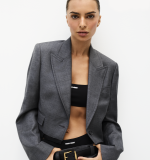



Source : harpersbazaar.com
